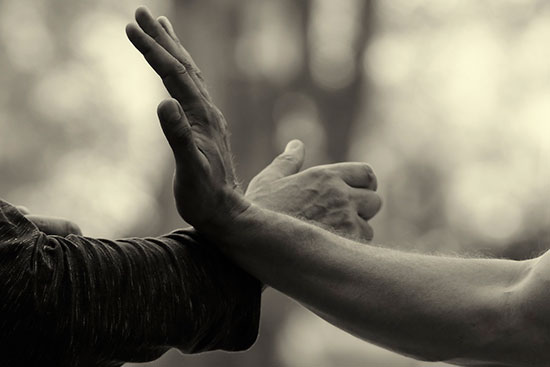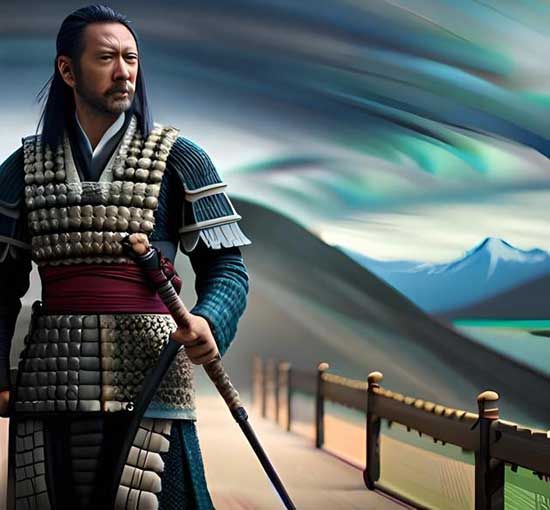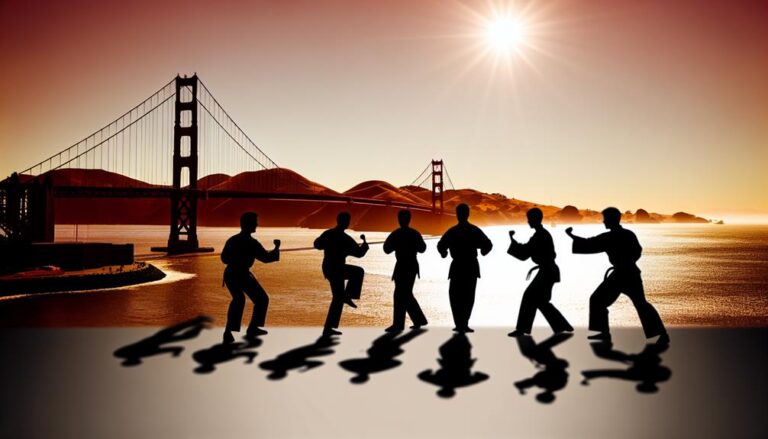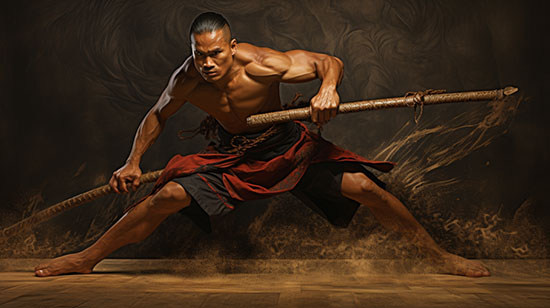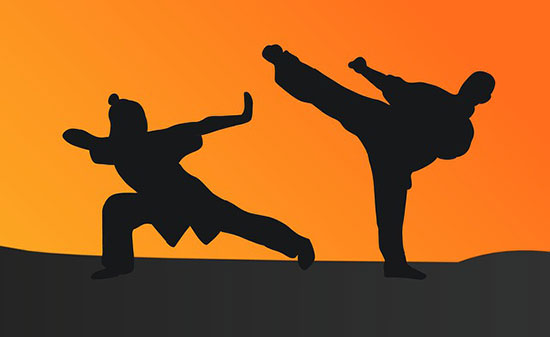Welcome to our comprehensive comparison guide on Capoeira and Karate, two distinct martial arts with their own histories, techniques, and benefits.
Whether you’re a beginner looking to start your martial arts journey or a seasoned practitioner curious about the differences between these arts, this guide will provide you with valuable insights. So let’s dive in and explore the fascinating world of Capoeira and Karate!
Key Takeaways:
- Capoeira and Karate are two distinct martial arts with their own unique characteristics.
- Capoeira combines fluid movements, acrobatics, and music, offering physical and mental benefits such as agility, flexibility, and body awareness.
- Karate focuses on powerful strikes, kicks, and knee strikes, promoting physical fitness, self-confidence, and mental focus.
- Both arts incorporate self-defense techniques, providing practitioners with the skills to protect themselves.
- Choosing between Capoeira and Karate depends on individual preferences, goals, and interests.
Contents
The Origins and Histories of Capoeira and Karate
Capoeira, with its roots in African and Indigenous Brazilian cultures, originated in Brazil. Developed by enslaved Africans, capoeira was initially disguised as a dance to evade suspicion from slave owners.
Over time, it evolved into a martial art that incorporates acrobatics and music. The rich history of capoeira reflects the resilience and creativity of those who practiced it, using their cultural traditions as a form of self-expression and resistance.
Karate, on the other hand, traces its beginnings to Okinawa, Japan, during the Ryukyu Kingdom era. It was initially practiced in secret for self-defense purposes. As karate gained popularity, it became an established martial art that spread throughout Japan and eventually gained international recognition.
The history of karate is deeply intertwined with the cultural and historical context of Okinawa, reflecting the values and traditions of the people who developed and practiced the art.
These distinct histories highlight the diverse origins and cultural influences that shaped capoeira and karate. While capoeira emerged from the struggles of enslaved Africans in Brazil, karate originated in a time of political upheaval in Okinawa.
Understanding the historical context allows us to appreciate the significance of these martial arts and the impact they have had on the societies in which they originated.
Cultural Influences:
Capoeira: African and Indigenous Brazilian cultures
| Capoeira | Karate | |
|---|---|---|
| Origin | Brazil, influenced by African and Indigenous Brazilian cultures | Okinawa, Japan, influenced by Okinawan culture during the Ryukyu Kingdom era |
| Disguised Origin | Disguised as a dance to evade suspicion from slave owners | Practiced in secret for self-defense purposes |
| Evolution | Incorporated acrobatics and music | Emphasized powerful strikes and kicks |
| Cultural Significance | Reflects the resistance and cultural traditions of enslaved Africans in Brazil | Reflects the values and traditions of Okinawan culture during a time of political upheaval |
Techniques in Capoeira and Karate
Capoeira and Karate employ distinct techniques that showcase the unique characteristics of each martial art.
Capoeira Techniques
Capoeira is renowned for its fluid and acrobatic movements that seamlessly blend dance, acrobatics, and music with combat techniques. Its circular motion and emphasis on agility and flexibility set it apart from other martial arts.
Some prominent capoeira techniques include:
- Ginga: The fundamental movement in capoeira, a continuous back-and-forth swaying motion that allows practitioners to transition smoothly between attacks and defenses.
- Meia Lua de Compasso: Translated as “half-moon from a compass,” this spinning kick is one of the signature moves in capoeira. It involves a circular motion executed with a swinging leg to strike opponents.
- Armada: A powerful spinning kick performed in a circular motion, targeting the upper body or head of the opponent.
These techniques in capoeira are executed with grace and finesse, requiring practitioners to develop a strong sense of balance, coordination, and timing.
Karate Techniques
Karate, on the other hand, emphasizes powerful strikes, kicks, and knee strikes executed with precision and force.
Key karate techniques include:
- Reverse Punch (Gyaku-zuki): A straight punch delivered with the rear hand, utilizing the entire body’s rotation for maximum impact.
- Front Kick (Mae Geri): A straightforward, powerful kick executed with the ball of the foot, targeting the abdominal region or head of the opponent.
- Roundhouse Kick (Mawashi Geri): A dynamic kick delivered in a circular motion, striking the opponent with the top of the foot or the shin.
Karate techniques require practitioners to develop strength, speed, and focus to deliver effective strikes and defend against attacks.
Capoeira vs Karate Techniques
| Technique | Capoeira | Karate |
|---|---|---|
| Ginga | Fluid swaying motion | N/A |
| Meia Lua de Compasso | Spinning kick | N/A |
| Armada | Powerful spinning kick | N/A |
| Reverse Punch (Gyaku-zuki) | N/A | Straight punch with rotation |
| Front Kick (Mae Geri) | N/A | Straightforward kick with the ball of the foot |
| Roundhouse Kick (Mawashi Geri) | N/A | Circular kick with the top of the foot or shin |
While capoeira focuses on fluid movements, acrobatics, and circular strikes, karate emphasizes powerful linear strikes. These differences in techniques reflect the distinct philosophies and styles of capoeira and karate.
Benefits of Capoeira and Karate
Both Capoeira and Karate offer a range of physical and mental benefits for practitioners. Whether you’re interested in improving fitness, gaining self-confidence, or enhancing mental focus, both martial arts have something to offer. Let’s explore the unique benefits of each art:
Capoeira Benefits:
- Improved Strength and Flexibility: Capoeira’s dynamic movements require strength and flexibility, helping to tone muscles and increase range of motion.
- Cardiovascular Endurance: The fast-paced nature of capoeira provides an excellent aerobic workout, boosting cardiovascular fitness and stamina.
- Agility and Body Awareness: Capoeira’s acrobatic movements and constant motion improve agility, coordination, and body awareness.
- Rhythm and Musicality: Capoeira incorporates music and rhythm, allowing practitioners to develop a sense of timing and musicality.
Karate Benefits:
- Physical Fitness: Karate training focuses on building strength, speed, and power, leading to improved overall physical fitness.
- Coordination and Balance: Precise techniques in Karate enhance coordination and balance, promoting better body control and spatial awareness.
- Self-Confidence: As practitioners progress in Karate, they gain self-confidence through mastering new skills and achieving goals.
- Mental Focus: Karate requires mental concentration and discipline, helping to develop focus and clarity of mind.
Overall, both Capoeira and Karate provide opportunities for personal growth and self-expression. Whether you’re drawn to the fluid movements and acrobatics of Capoeira or the powerful strikes and discipline of Karate, both martial arts offer a holistic approach to physical well-being and mental development.
Next, we will explore the specific self-defense aspects of Capoeira and Karate, delving into the techniques and strategies employed by practitioners to protect themselves in real-world situations.
| Capoeira | Karate | |
|---|---|---|
| Physical Benefits | Improved strength, flexibility, agility, cardiovascular endurance, and body awareness. | Enhanced physical fitness, coordination, balance, and power. |
| Mental Benefits | Cultivates rhythm, musicality, and promotes mental agility. | Builds self-confidence, mental focus, and discipline. |
| Self-Defense Techniques | Combines evasive maneuvers, kicks, sweeps, and acrobatics for effective self-defense. | Emphasizes powerful strikes, kicks, and knee strikes for self-defense. |
Self-Defense in Capoeira and Karate
In the realm of self-defense, both capoeira and karate offer practitioners effective techniques to protect themselves in various situations. While capoeira utilizes fluid movements and acrobatics, karate emphasizes powerful strikes and direct strikes. Let’s explore the self-defense aspects of both martial arts.
Capoeira Self-Defense Techniques
In capoeira, self-defense techniques are seamlessly integrated into the art’s fluid movements and acrobatics. Practitioners learn to utilize evasive maneuvers, kicks, and sweeps to effectively defend themselves against attackers. The acrobatic elements of capoeira also enable practitioners to evade attacks and create strategic opportunities to counterattack.
Capoeira’s emphasis on agility and flexibility allows practitioners to swiftly maneuver and escape dangerous situations. By combining graceful movements with precise strikes and evasions, capoeira provides a unique approach to self-defense that prioritizes strategic positioning and adaptability.
Karate Self-Defense Techniques
Unlike capoeira, karate focuses on direct and powerful strikes to neutralize threats. Practitioners learn a range of strikes, kicks, and knee strikes that can be effectively employed in self-defense situations. Karate training emphasizes developing strong stances, precise techniques, and the ability to react quickly to any signs of danger.
Karate’s emphasis on discipline and mental focus also plays a crucial role in self-defense. By cultivating mental resilience and sharpening their instincts, karate practitioners are capable of making split-second decisions and effectively defending themselves when faced with confrontational situations.
Comparison of Self-Defense Approaches
While capoeira and karate have different approaches to self-defense, both arts provide valuable skills for personal protection. Capoeira’s fluid and acrobatic movements enable practitioners to evade attacks with agility and create openings for counter-attacks.
In contrast, karate’s emphasis on powerful strikes and precise techniques equips practitioners with the ability to incapacitate attackers quickly. Both capoeira and karate instill practitioners with the confidence, situational awareness, and physical skills necessary to defend themselves effectively.
| Capoeira | Karate | |
|---|---|---|
| Primary Techniques | Fluid movements, acrobatics, kicks, sweeps, evasive maneuvers | Powerful strikes, kicks, knee strikes, precise techniques |
| Focus | Strategic positioning, adaptability, agility | Direct impact, quick reaction, discipline |
| Strengths | Evasion, counter-attacks, acrobatic evasion | Powerful strikes, quick reactions, discipline |
| Considerations | Requires flexibility, adaptability, and spatial awareness | Emphasizes mental focus, discipline, and physical conditioning |
Ultimately, the choice between capoeira and karate as a self-defense practice depends on individual preferences, goals, and interests. Some may find capoeira’s fluidity and acrobatics appealing, while others may prefer karate’s power and precision. To determine which martial art suits you best, it is recommended to try introductory classes of both capoeira and karate.
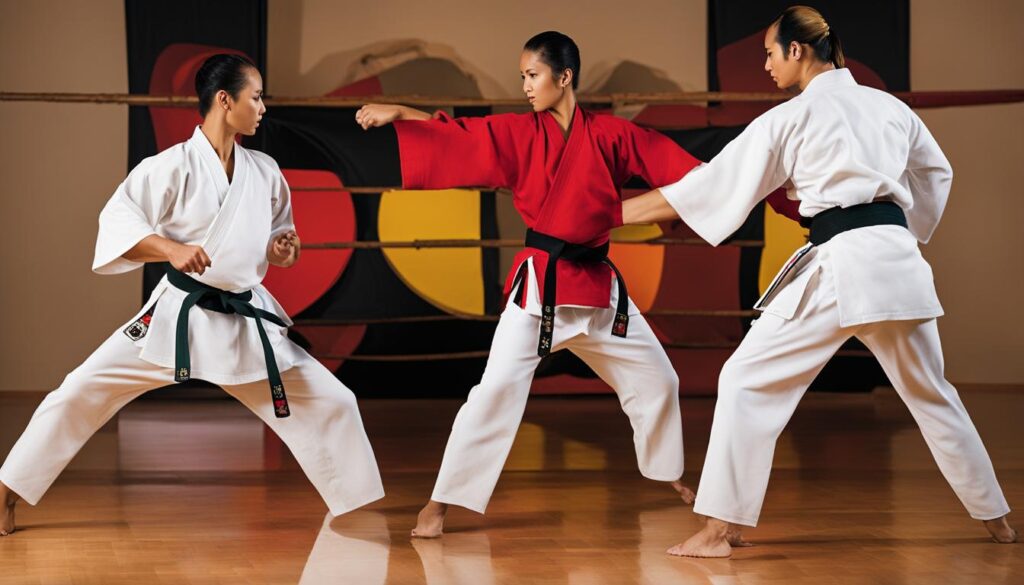
Conclusion
In conclusion, capoeira and karate are two distinct martial arts that offer unique characteristics and benefits. Capoeira combines fluid movements, acrobatics, and music, promoting agility, flexibility, and body awareness. On the other hand, karate focuses on powerful strikes, kicks, and knee strikes, enhancing physical fitness, self-confidence, and mental focus.
Both capoeira and karate incorporate self-defense techniques, equipping practitioners with the skills to protect themselves. However, the choice between the two arts ultimately depends on individual preferences, goals, and interests. It is recommended to try introductory classes of both capoeira and karate to determine which one suits you best.
By comparing capoeira and karate, we can see the differences in their techniques, histories, and benefits. Whether you are drawn to the rhythmic and acrobatic nature of capoeira or prefer the power and precision of karate, both martial arts offer valuable physical and mental development. So, explore the world of capoeira and karate, and discover the martial art that resonates with you!
